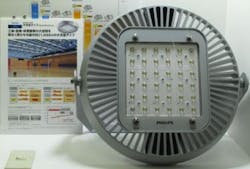| This high-output LED lamp by Royal Philips has a maximum luminous flux of 21,000 lm. (Image: Tech-On!) |
As noted in Tech-On!, a wide variety of ultrahigh-output white-light LED lamps, intended to replace the standard mercury lamp for outdoor and arena lighting, were shown at LED Next Stage 2014 (March 4-7; Tokyo, Japan).
For LED manufacturers to continue growing past the point that the indoor LED-lighting market begins to saturate (as it's already doing in Japan), they need to tackle other markets -- which they're now doing.
The ultrabright LED lamps will replace mercury lamps, metal halide lamps, and high-intensity-discharge (HID) floodlights used as street lamps and for lighting manufacturing plants, storehouses, gymnastic halls, stadiums, and so on.
At the trade show, many LED lamps and floodlights having high outputs equivalent to 1000 to 1500 W were exhibited. Many of them have a brightness equivalent to that of a metal halide lamp and a 50% to 70% lower power consumption.
A sampling of the exhibit
Iwasaki Electric Co Ltd showcased its "LEDioc Flood Duell," an LED floodlight targeted at lighting systems for golf practice ranges and stadiums such as baseball stadiums. The luminous flux of the Flood Duell is 74,500-95,000 lm for a 1000 W model -- equivalent to a 1500 W metal halide lamp. The company's "LEDioc Flood Suporato" has a brightness equivalent to or higher than that of a 400 W mercury lamp and reduces power consumption by about 70%.
The "Lanstar ZLS-300" high-brightness LED floodlight exhibited by Furukawa has a rated power consumption of 300 W and a luminous flux of 27,000 lm, equivalent to the brightness of a 1200 W mercury lamp.
Royal Philips NV showed an LED lamp for high ceilings, with a luminous flux is 21,000 lm; if 60 mercury lamps are replaced with the new lamps in a large building, brightness increases by 120% and the power consumption decreases by 48%, the company says. The introductory cost of the LED lamp is still higher than that of a mercury lamp, but it's more efficient and lasts longer.
The cost of the LED lamp will become equivalent to that of a mercury lamp in about 2.4 years and lower after that, Royal Philips says.
Source: http://techon.nikkeibp.co.jp/english/NEWS_EN/20140311/339320/
